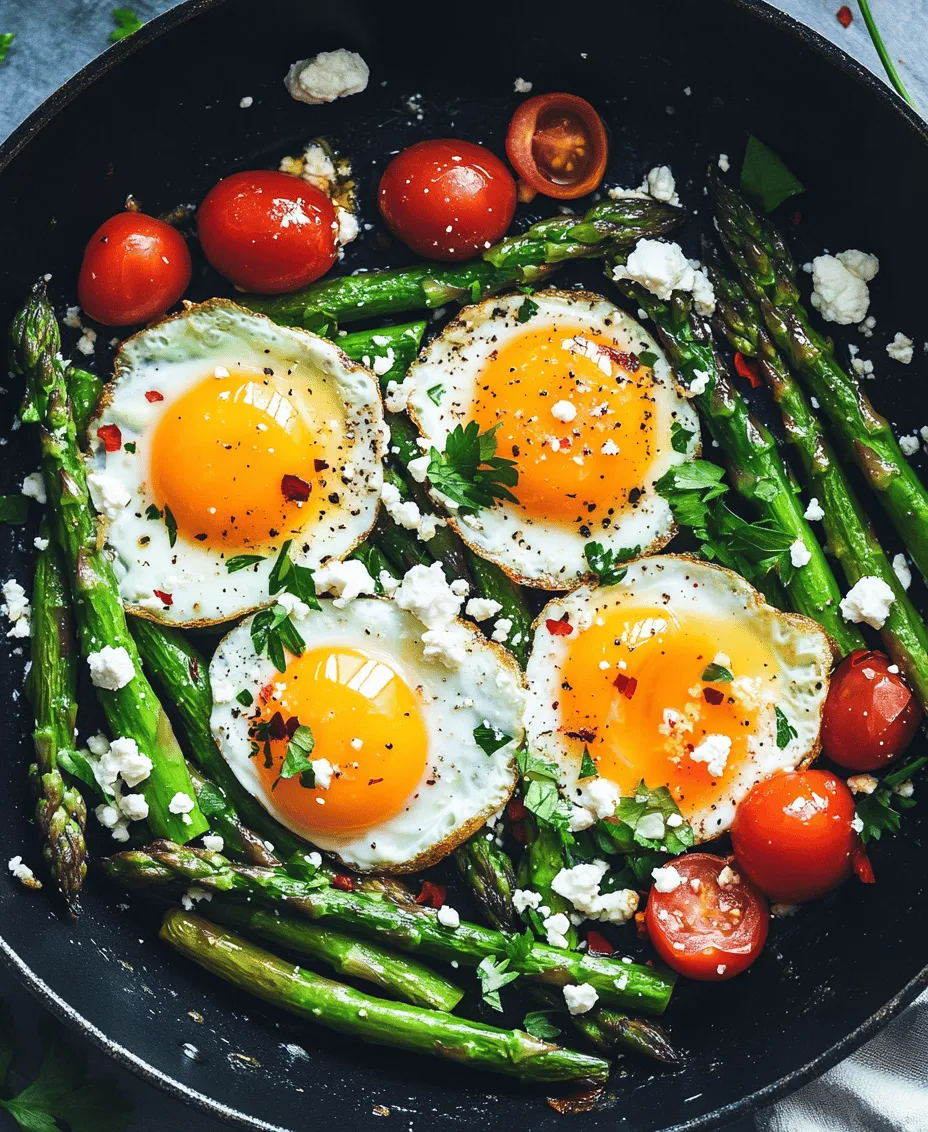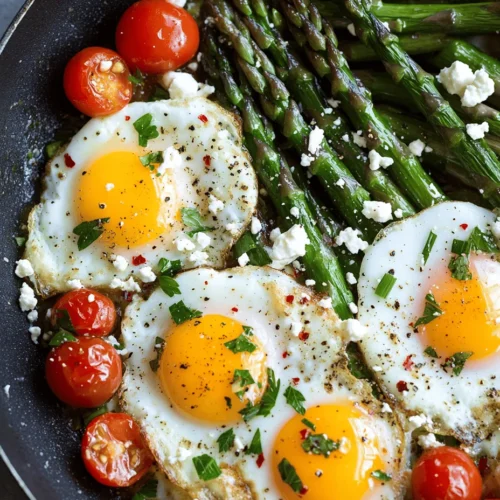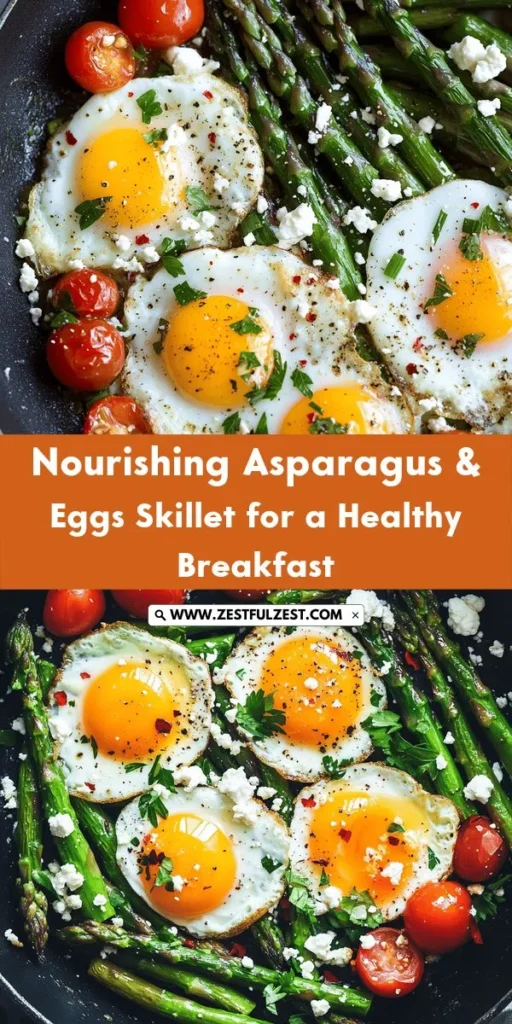Introduction
Breakfast is often hailed as the most important meal of the day, and for good reason. A healthy breakfast provides the necessary fuel to kickstart your metabolism after a long night of fasting. It’s an opportunity to nourish your body with essential nutrients, setting a positive tone for the rest of your day. Among a myriad of breakfast options, the Asparagus & Eggs Breakfast Skillet stands out as a vibrant and nutritious choice, perfect for anyone looking to embrace a healthier lifestyle without compromising on flavor.
This delicious skillet combines fresh asparagus, farm-fresh eggs, and other wholesome ingredients into a satisfying dish that is not only easy to prepare but also bursting with flavor. The beauty of this recipe lies in its simplicity; it requires minimal prep time and can be whipped up in just half an hour. With its colorful presentation and nutrient-dense ingredients, it’s a delightful way to start your morning right.
Not only does this breakfast skillet pack a punch in terms of taste, but it also highlights the importance of using fresh ingredients. Seasonal vegetables and high-quality produce elevate the dish, ensuring you get the most out of your breakfast while enjoying a medley of flavors. Whether you’re a busy professional, a health-conscious individual, or simply a fan of delicious food, the Asparagus & Eggs Breakfast Skillet is sure to become a staple in your morning routine.
Understanding the Ingredients
Overview of Asparagus: Nutritional Benefits and Culinary Versatility
Asparagus is a nutrient-dense vegetable that is often overlooked in breakfast dishes. This green stalk is a powerhouse of vitamins and minerals, including vitamin K, folate, and vitamins A, C, and E. Its high fiber content aids in digestion, while its antioxidants help combat oxidative stress in the body. The unique, slightly earthy flavor of asparagus lends itself well to both savory and sweet dishes, making it a versatile ingredient in any kitchen.
Culinary-wise, asparagus can be enjoyed in various forms—whether grilled, roasted, steamed, or sautéed. For our breakfast skillet, lightly sautéing the asparagus enhances its natural flavors while maintaining a satisfying crunch, making it an ideal base for the dish.
The Role of Eggs in Breakfast: Protein Powerhouse and Health Benefits
When it comes to breakfast staples, eggs are revered for their incredible versatility and nutritional value. Packed with high-quality protein, eggs serve as a complete source of essential amino acids, which are crucial for muscle repair and growth. They’re also rich in vitamins B12 and D, as well as healthy fats, promoting satiety and overall well-being.
In the Asparagus & Eggs Breakfast Skillet, eggs are the star of the show. When cooked to perfection, they add a creamy, rich texture that complements the crispiness of the asparagus and the tanginess of feta cheese. Whether you prefer them scrambled or lightly fried with a runny yolk, the eggs elevate the dish, making it hearty and filling.
Importance of Olive Oil: Healthy Fats and Flavor Enhancer
Olive oil is a staple in Mediterranean cuisine and is lauded for its numerous health benefits. Rich in monounsaturated fats, olive oil supports heart health and reduces inflammation. It is also packed with antioxidants, contributing to overall health and wellness.
In our breakfast skillet, olive oil serves two crucial roles: it enhances the flavor of the dish and helps with the cooking process. The oil acts as a medium to sauté the vegetables, ensuring they cook evenly while maintaining their vibrant colors and flavors. Choosing a high-quality extra virgin olive oil can further elevate your dish, infusing it with a rich, fruity flavor.
Benefits of Cherry Tomatoes: Vitamins, Antioxidants, and Vibrant Color
Cherry tomatoes are a fantastic addition to any breakfast dish, not just for their taste but also for their health benefits. These small yet mighty fruits are rich in vitamins C and K, potassium, and antioxidants, particularly lycopene, which is known for its heart-protective properties and potential cancer-fighting abilities.
Their natural sweetness and juicy texture add a burst of flavor to the Asparagus & Eggs Breakfast Skillet, creating a delightful contrast with the other ingredients. Furthermore, their vibrant red color enhances the visual appeal of the dish, making it even more inviting.
Feta Cheese: Flavor Profile and Nutritional Content
Feta cheese is a staple in Mediterranean cuisine, known for its tangy flavor and crumbly texture. Made from sheep’s milk or a combination of sheep and goat’s milk, feta cheese is lower in calories and fat compared to many other cheeses, making it a healthier option for breakfast.
Incorporating feta into the breakfast skillet adds a rich, salty flavor that complements the earthiness of the asparagus and the sweetness of the tomatoes. Additionally, feta is a source of protein and calcium, contributing to the dish’s overall nutritional profile.
Garlic and Red Pepper Flakes: Adding Flavor and Health Benefits
Garlic is a culinary powerhouse, known for its potent flavor and numerous health benefits. It contains allicin, a compound with antimicrobial and anti-inflammatory properties that can help boost the immune system. Garlic also adds depth to the Asparagus & Eggs Breakfast Skillet, enhancing the overall flavor profile.
Red pepper flakes introduce a mild heat that can elevate the dish without overwhelming the palate. This spice not only adds a kick but also contains capsaicin, which has been shown to boost metabolism and promote fat burning. The combination of garlic and red pepper flakes creates a flavorful base that ties the entire dish together.
The Significance of Fresh Herbs for Garnish
Fresh herbs are often the unsung heroes of many recipes, bringing bright flavors and visual appeal to the table. In the Asparagus & Eggs Breakfast Skillet, herbs like parsley or chives can be used as a garnish, enhancing the overall taste while adding a pop of color.
Herbs are also packed with vitamins, minerals, and antioxidants, providing additional health benefits to your meal. A sprinkle of fresh herbs just before serving can elevate the dish from simple to extraordinary, making it a feast for both the eyes and the taste buds.
Preparation and Cooking Techniques
Creating a delicious Asparagus & Eggs Breakfast Skillet requires a few essential kitchen tools and a straightforward cooking method. Here’s a breakdown of what you’ll need to get started.
Essential Kitchen Tools for the Skillet Recipe
1. Skillet: A good-quality non-stick or cast-iron skillet is ideal for this recipe. These materials ensure even cooking and allow for easy food release.
2. Cutting Board: A sturdy cutting board is essential for chopping your vegetables.
3. Chef’s Knife: A sharp chef’s knife will make quick work of chopping asparagus, tomatoes, and herbs.
4. Spatula: A flexible spatula will help you stir and flip the eggs without damaging them.
5. Measuring Cups and Spoons: Accurate measuring tools will ensure you use the right quantities of ingredients.
Recommended Skillet Types
While several types of skillets can be used for this recipe, here are two recommendations:
– Non-Stick Skillet: This is perfect for beginners or those who want a hassle-free cooking experience. Food is less likely to stick, and cleanup is easier.
– Cast Iron Skillet: A cast iron skillet retains heat exceptionally well and can develop a non-stick surface over time with proper care. It adds a rustic touch and is great for even cooking.
Tools for Chopping and Preparing Ingredients
Having the right tools for chopping and preparing your ingredients will save you time and effort. Here are a few suggestions:
– Vegetable Peeler: This is useful for trimming the tough ends of the asparagus if desired.
– Herb Scissors: For quickly chopping fresh herbs, herb scissors can save you time and effort.
– Mixing Bowls: Use a mixing bowl to whisk the eggs before adding them to the skillet.
Step-by-Step Cooking Method Explained
Now that you’re familiar with the ingredients and tools, let’s dive into the cooking process. Follow these steps for a successful Asparagus & Eggs Breakfast Skillet:
1. Prep the Ingredients: Start by washing the asparagus and cherry tomatoes. Cut the asparagus into 1-inch pieces. Halve the cherry tomatoes and set them aside. Mince the garlic and chop the fresh herbs.
2. Heat the Skillet: Place your skillet over medium heat and add a tablespoon of olive oil. Allow the oil to heat for about 1 minute. It’s essential to let the oil reach the right temperature to ensure the asparagus gets a nice sear.
3. Sauté the Asparagus: Once the oil is hot, add the chopped asparagus to the skillet. Sauté for about 3-4 minutes, stirring occasionally, until the asparagus is tender yet still crisp.
4. Add Garlic and Red Pepper Flakes: After the asparagus is cooked, add the minced garlic and a pinch of red pepper flakes. Sauté for an additional minute until the garlic becomes fragrant.
5. Incorporate the Tomatoes: Add the halved cherry tomatoes to the skillet, stirring to combine. Cook for another 2 minutes until the tomatoes start to soften.
6. Whisk the Eggs: In a separate bowl, whisk the eggs until well combined. Season with salt and pepper to taste.
7. Pour in the Eggs: Create a slight well in the center of your vegetable mixture and pour the whisked eggs into the skillet. Allow them to cook undisturbed for about 1-2 minutes until the edges begin to set.
8. Scramble or Cook to Desired Doneness: Using a spatula, gently stir the eggs into the vegetable mixture, cooking until the eggs are set but still creamy.
9. Add Feta Cheese: Crumble feta cheese over the top of the skillet and let it warm through for a minute before removing the skillet from heat.
Preparing the Skillet: Why Oil Temperature Matters
Understanding oil temperature is crucial for achieving the perfect sautéed vegetables. If the oil is not hot enough, the asparagus may become soggy instead of developing that desirable crisp-tender texture. Conversely, if the oil is too hot, it can cause the garlic to burn, resulting in a bitter taste. The ideal temperature allows for a quick sear, locking in flavors while providing a beautiful golden color.
By mastering these initial steps and understanding the importance of each ingredient, you’re well on your way to creating a nutritious and flavorful Asparagus & Eggs Breakfast Skillet that will energize your mornings and delight your taste buds. Stay tuned for the next part, where we’ll delve deeper into serving suggestions and tips for customizing this delightful breakfast dish!

Techniques for Sautéing Vegetables to Retain Nutrients
Sautéing vegetables is a quick and effective cooking technique that can help preserve their nutrients while enhancing flavor. When preparing your Asparagus & Eggs Breakfast Skillet, consider these techniques to maximize the nutritional value of your ingredients:
1. Use High Heat for a Shorter Time: Sautéing over medium-high heat allows vegetables to cook quickly, reducing the time they spend exposed to heat. This method helps retain water-soluble vitamins, such as Vitamin C and B vitamins, which can be lost during prolonged cooking.
2. Don’t Overcrowd the Pan: When sautéing, give your vegetables enough space to cook evenly. Overcrowding the pan can lead to steaming rather than sautéing, which may prevent browning and alter the texture. If necessary, cook in batches to achieve the best results.
3. Add a Splash of Water or Broth: To enhance flavor and retain nutrients, consider adding a small amount of vegetable broth or water to the pan while sautéing. This not only helps to steam the vegetables slightly but also prevents them from burning.
4. Keep the Skins On: Whenever possible, leave the skins on your vegetables. For asparagus, this not only adds a bit of texture but also retains additional nutrients that are often found just beneath the skin.
5. Use Fresh Ingredients: Fresh, seasonal vegetables are generally more nutrient-dense than those that have been stored for long periods. Whenever possible, choose local, in-season asparagus and other vegetables to maximize both flavor and nutrition.
Tips for Achieving the Perfect Eggs
Cooking eggs to perfection is key to elevating your Asparagus & Eggs Breakfast Skillet. Here are some tips based on your preferences for egg doneness:
1. Soft Scrambled Eggs: For creamy, soft scrambled eggs, cook them on low heat, stirring gently with a spatula. Remove from heat when slightly undercooked, as they will continue to cook off the heat. This usually takes about 3-4 minutes.
2. Medium Cooked Eggs: If you prefer medium-cooked eggs with a slightly runny yolk, cook them over medium heat for about 5-6 minutes. Gently break the yolks into the vegetables at the end of the sautéing process, allowing them to cook slightly in the residual heat.
3. Hard Cooked Eggs: For fully cooked eggs, aim for 7-8 minutes of cooking. Avoid overcooking, as this can lead to a rubbery texture. Instead, consider covering the skillet for the last minute to help set the yolks without overdoing them.
4. Creating Wells for Eggs: To achieve beautifully cooked eggs in your skillet, create small wells in the sautéed vegetables using the back of a spoon. This provides a snug place for the eggs, ensuring they cook evenly. Simply make an indentation in the vegetables before cracking the eggs into the skillet.
Nutritional Analysis
One of the appealing aspects of the Asparagus & Eggs Breakfast Skillet is its excellent nutritional profile. Here’s a breakdown of what you can expect per serving:
– Calories: Approximately 250-300 calories, depending on the type of cheese and oil used.
– Macronutrients:
– Protein: 18-22 grams (primarily from eggs and cheese)
– Carbohydrates: 10-15 grams (mainly from asparagus and any additional vegetables)
– Fat: 15-20 grams (from olive oil and cheese)
– Vitamins: Rich in Vitamin A (from eggs), Vitamin C (from asparagus), and Vitamin K.
This recipe aligns well with various dietary preferences:
– Mediterranean Diet: High in vegetables and healthy fats, making it an excellent fit.
– Low-Carb Diets: With minimal carbohydrates, it can be a satisfying option for those monitoring carb intake.
Starting your day with balanced nutrition is essential for sustained energy and focus. The combination of protein, healthy fats, and fiber-rich vegetables in this recipe ensures a nutritious breakfast that fuels your morning.
Flavor Variations and Customizations
The Asparagus & Eggs Breakfast Skillet is highly adaptable. Here are some suggestions for customizing the recipe to suit your palate:
1. Ingredient Swaps: While asparagus is the star of this dish, you can substitute it with other vegetables such as:
– Spinach or kale for a leafy green option
– Bell peppers for added sweetness
– Zucchini for a mild, tender texture
2. Cheese Choices: While feta cheese adds a tangy flavor, feel free to experiment with:
– Goat cheese for a creamy option
– Cheddar cheese for a sharper taste
– Nutritional yeast for a dairy-free, cheesy flavor
3. Spice Variations: Elevate the flavor profile by adding:
– Fresh herbs like basil, parsley, or cilantro for freshness
– Dried spices such as smoked paprika, cumin, or chili flakes for warmth
– A dash of hot sauce for a spicy kick
4. Vegetarian or Vegan Options: To adapt this recipe for vegetarian or vegan diets, consider:
– Replacing eggs with tofu scramble or chickpea flour scrambled eggs.
– Using plant-based cheese or omitting cheese altogether.
Serving Suggestions
To create a well-rounded breakfast experience, consider these serving suggestions:
1. Accompaniments: Pair your skillet with:
– Whole grain toast or avocado toast for added fiber
– Fresh fruit such as berries or melon to balance the savory flavors
– A dollop of Greek yogurt for creaminess and protein
2. Presentation Tips: To make your breakfast visually appealing:
– Serve in a vibrant cast-iron skillet or a colorful plate.
– Garnish with fresh herbs or a sprinkle of chili flakes for a pop of color.
3. Meal Prep and Storage: If you have leftovers, store them in an airtight container in the refrigerator for up to three days. Reheat gently on the stovetop or in the microwave. For meal prep, consider batch-cooking vegetables and eggs separately, then combining them fresh each morning.
Conclusion
The Asparagus & Eggs Breakfast Skillet is a delightful, healthy, and easy-to-make breakfast option that brings seasonal ingredients to the forefront. With its rich flavor and nutritional benefits, this dish not only satisfies hunger but also supports a balanced diet.
Incorporating fresh vegetables and wholesome ingredients into your daily meals is a wonderful way to enhance your overall health. By personalizing this recipe to fit your tastes and dietary needs, you can explore the versatility of this dish while enjoying the benefits of a nutritious breakfast.
Embrace the joy of cooking by trying out different combinations and flavors, and let this Asparagus & Eggs Breakfast Skillet inspire your morning routine. Whether you keep it classic or make it your own, this recipe is sure to become a favorite in your kitchen.



